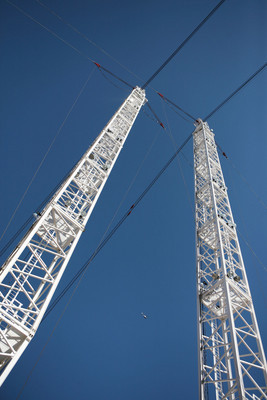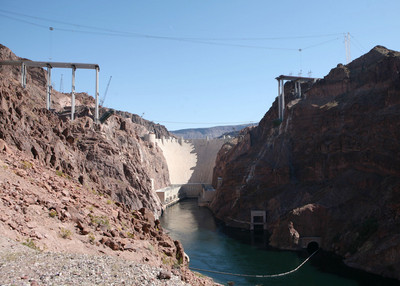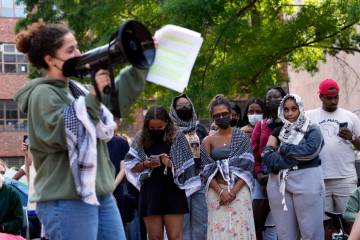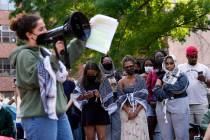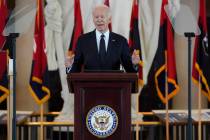TOWERING ACHIEVEMENT
The Hoover Dam bypass is beginning to take shape after nearly five years of work. Seven soaring concrete columns -- five on the Nevada side and two on the Arizona side, forming the approach spans -- protrude from the dark rock.
But what's left to build is what project manager Dave Zanetell calls the hard part: the 1,060 twin-rib concrete arch that will span Black Canyon.
Its construction will require hoisting workers and up to 50 tons of materials 890 feet above the Colorado River via 2,300-foot-long steel cables, held aloft by a pulley-type "high-line" crane system.
The original crane towers collapsed amid 55 mph winds. Now, 17 months later, the replacement crane system is up and running.
The primary contractors, a multinational conglomerate made up of Obayashi Corp. and PSM Construction USA Inc., absorbed the cost of rebuilding the crane system.
Project officials had hoped the crane collapse would only delay the $240 million bridge project by six months. The bridge was originally to have been completed by the end of this year. But officials now believe it will open to traffic in late 2010.
When complete, it will be the longest concrete arch bridge in the Western Hemisphere, said Zanetell, who is with the Federal Highway Administration.
But "the hardest work is yet to be done," he said.
The arches will be made of 106 pieces -- 53 in each arch -- cast 24 feet at a time.
The first two segments of the arch on each side of the approach spans are already complete and will act as a springboard for the remaining segments.
Next, two towers will be erected on top of the approach spans, and cables running from the towers to the concrete segments will support the concrete segments, he said. The two towers will also be stabilized by cables running back to the canyon rim.
The arch should be complete and self-supporting by September 2009, Zanetell said.
Concrete columns will then be erected on top of the arch, along with the road and deck part of the bridge. The bridge will provide four lanes for the U.S. Highway 93 traffic that currently uses the two-lane route over the dam.
Standing on the edge of the Nevada side of the approach span last week, more than 1,000 feet above the Colorado River, Zanetell said completion was within sight.
He toured the construction site with U.S. Secretary of Transportation Mary Peters, who agreed.
"It's an engineering marvel," she said.
More than 17,000 cars and trucks are expected to use the new bridge on a daily basis, a number expected to grow by 50 percent over the next 20 years.
More than 2,000 trucks detour around the dam daily via U.S. Highway 95 to a river crossing in Laughlin. Most truck traffic was banned from the dam after the terrorist attacks of Sept. 11, 2001.
While waiting for the cranes to be rebuilt, engineers pushed other parts of the project forward that did not rely on the high-line crane system. The Federal Highway Administration awarded Las Vegas Paving Corp. a $7 million paving and guardrail contract for the approaching roadways.
The paving project, which will include 60,000 tons of crushed rock, 45,000 tons of asphalt and more than 17,000 feet of guardrail, is expected to be completed this summer.
Once the bridge is complete, a final paving contract worth about $9 million will be awarded for the roadway over the bridge as well as the tie-ins to U.S. 93.
The bridge will include a walkway, a parking area, and a pedestrian plaza. The walkway will feature panoramic views of the Hoover Dam. Motorists driving over the bridge will not be able to see the dam from the roadway.
The new structure will be named the Mike O'Callaghan-Pat Tillman Memorial Bridge. O'Callaghan was a popular two-term governor of Nevada, and Tillman was an Arizona Cardinals football star who joined the military after the 2001 attacks and was killed accidentally by fellow U.S. soldiers in Afghanistan.
Contact reporter Francis McCabe at fmccabe @reviewjournal.com or (702) 387-2904.
Photo Slideshow



